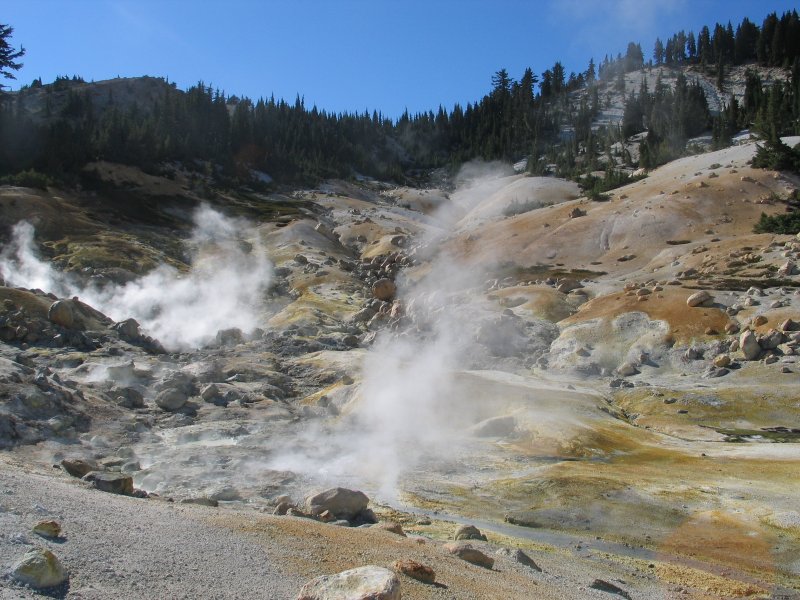When we think of volcanic conditions, our minds leap to images of vast eruptions like Mount St. Helens in Washington State, or lava oozing down the slopes of Kilauea on the Big Island of Hawaii. With my family, I once visited that lava flow.
We are used to stones being “rock solid” but here molten orange-hot rock oozes across a two-lane road and pours over a cliff, causing clouds of steam to erupt from the Pacific Ocean.
My daughter Ásta, five years old at the time, was understandably very suspicious of the stuff and would not go near the lava flow. It radiated an oven-like heat, even from fifty feet away.
Most of our planet is like this lava, even hotter, still molten from radioactive elements disintegrating in the iron-nickel core and the residual heat generated by the violent impacts and collisions that formed the Earth 4.5 billion years ago. We live on a thin rocky crust that is frozen only because it constantly radiates heat into outer space. But there is more to volcanic activity than just erupting conical mountains and lava flows. Yellowstone National Park, for instance, sits on the remains of an enormous volcanic eruption that took place 640,000 years ago. Water from rain and melting snow seeps down into hot rock beneath the surface, then vaporizes and erupts in spouting geysers and roaring vents called fumaroles.
I am fascinated by these hydrothermal systems, because they are as close as we can get to the kinds of environments on the early Earth that may have given rise to life. Mostly researchers work in safe, comfortable, clean laboratories, but life did not begin in a lab. It began in conditions more closely resembling the chaotic geology of volcanoes that rose above an early ocean as Hawaii and Iceland do today, or perhaps in submarine sites such as the hydrothermal vents discovered in the early 1980s.
To satisfy my curiosity, I have traveled twice to Kamchatka, in far eastern Russia, with NASA-supported research teams. Kamchatka is one of the most volcanically active places on Earth, and if you ever have a chance, I can highly recommend taking one of the tours that are now offered by several commercial agencies. I also carry out research in a small hydrothermal outcrop within a mile of the road leading through Mount Lassen National Park in northern California. This site was discovered by Mr. Kendall Bumpass, a cowboy who worked near Mount Lassen in the 1860s. He was showing his discovery to a newspaper reporter when his foot broke through the crust over one of the boiling mud pots.
His leg was burned so badly it had to be amputated, and his name will live on in the name of the site: Bumpass Hell.
The field work I do provides a kind of reality check on laboratory experiments such as the research described in the last two columns. I wanted to see for myself what a prebiotic environment might have really been like, and how biological compounds behave in such environments. The results should help constrain our ideas on how life began by challenging some of the tacit assumptions we make when we do simulation experiments in the lab.
So, what did we find out? The results were sobering. The first thing you notice when you get up close and personal with a volcano is obvious to everyone: It’s hot! Not many researchers run their simulation experiments at near boiling temperatures, and yet we think that life began on a hot early Earth. The next observation is not so obvious, but also makes you think. When I measured the pH of the water in geothermal pools, it turns out to be very acidic, down in the range of stomach acid and lemon juice (pH 2 to 4 are typical values). This is due to the abundant sulfur in typical volcanic environments, which reek of acrid sulfur dioxide and the rotten egg odor of hydrogen sulfide.
When the sulfur compounds dissolve in water they react to produce acids.
This fact was brought home to me on my last trip to Bumpass Hell, where I had to kneel down to collect samples. On the way home the knees of my jeans disintegrated. The cloth had collected concentrated sulfuric acid that formed a thin, invisible film on the seemingly dry clay.

If the cellulose of cotton composing jeans breaks down in acid, how can we expect the polymers of early life to stand up to it?
Then there are the calcium, aluminum and iron salts that dissolve in acidic water. These bind to negatively charged groups like phosphate and carboxylate on important biological molecules, producing insoluble aggregates.
Finally, there is the clay problem. For years, we have thought that clay was a friend to researchers on the origin of life, and in fact certain kinds of clays have been shown to catalyze the synthesis of RNA from its monomers. But in volcanic ponds there is often lots of clay, so much that when we added gram quantities of amino acids, nucleic acid bases and phosphate to a small geothermal pond in Kamchatka, within minutes all of the compounds were adsorbed by the clay and removed from solution.
In other words, they became unavailable for any further reactions that would be needed for life to begin.
These results may help to constrain our ideas about the origin of life. As Sherlock Holmes used to say: when you exclude the impossible, whatever is left, however improbable, must be the answer.
Next week I will discuss some improbable solutions.






Comments